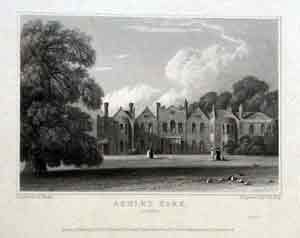Ashley Park facts for kids
Ashley Park is a private neighbourhood in Walton-on-Thames, Surrey. It's a place where people live in their own homes. Long ago, a very grand house called Ashley House stood here. This house was built around 1605 and changed over many years until it was taken down in the early 1920s. Famous people like Charles Sackville, 2nd Duke of Dorset and the wealthy Sassoon family once owned it.
Most of the land was turned into homes between the 1920s and 1940s. Many of these homes are large, separate houses. Some older ones are in the beautiful Arts and Crafts style, which was popular for its focus on craftsmanship. A local architect named Walter George Tarrant was known for building houses in this style here. When houses were sold, there were special rules called covenants to make sure the area remained spacious with not too many buildings.
Contents
History of Ashley Park House
Early Days of Ashley Manor
The land where Ashley Park is today was once known as Asshlees back in 1433. It was a small estate, about 16.5 acres, mostly covered in woods, with some open fields. This land became part of the larger estates connected to Hampton Court Palace.
Building Ashley House
The first real "Ashley House" was built between 1602 and 1605 by Lady Jane Berkeley. Over the centuries, the house was changed and updated many times. It was finally taken down between 1920 and 1925.
Important Owners of Ashley House
In 1625, King James I of England gave the land to Henry Gibb. By 1630, a wealthy tenant named Christopher Villiers, 1st Earl of Anglesey lived there. He was an important person in the King's court and likely made the estate even bigger.
After Lord Anglesey died, his wife Elizabeth and her new husband, Benjamin Weston, continued to live at Ashley House until 1662.
Later, in 1718, a military leader named Richard Boyle, 2nd Viscount Shannon bought the house and the rights to the land. He lived there until he died in 1740. Both Lord Anglesey and Lord Shannon are remembered in the local church in Walton-on-Thames.
Lord Shannon's only child, Grace, became the Countess of Middlesex. When she and her husband passed away without children, the estate went to her cousin, Colonel John Stephenson.
The house was later inherited by Sir Henry Fletcher, 1st Baronet, of Clea Hall, who was a Member of Parliament. His family owned Ashley House for many years. It stayed in their family until it was bought by Sassoon David Sassoon just before he died in 1867. His grandson, Sassoon Joseph Sassoon, and his young family were the last owners of the grand house.
It's known that one of the later Fletcher owners "pulled down a great deal of the house," meaning they made it smaller or changed it significantly.
Changes to the Estate
Former Golf Club
Around the 1890s, there was an Ashley Park Golf Club. However, it closed down before the First World War. The main Ashley House itself remained with the Sassoon family until it was demolished in 1920.
Turning the Estate into Homes
The large Ashley Park estate was developed into individual plots for houses in a few stages:
- When the Walton-on-Thames train station opened in 1838, the owners sold some land near the railway and public roads for smaller homes.
- By 1874, more people were traveling to work in the City of London. This led to groups of planned houses being built at the north end of Ashley Road. A large part of the eastern parkland was also used for building.
- In the 1920s, after S. Joseph Sassoon passed away, his family needed to sell parts of the estate to pay taxes and provide for his heirs. The large house was becoming very expensive to keep, so it was taken down.
- The remaining part of the estate was sold to a company that specifically developed the area. They sold plots of land and houses with special rules. These rules made sure the houses were expensive and that only separate, single-family homes could be built, keeping the area spacious.
The roads in the final part of the development were not given to the local council, which meant fewer sidewalks were built. However, the way the area was developed helped save many trees. These trees were once part of the golf course, the owner's private park, or ancient woodlands. A part of the park in the northwest became a public green space, also called Ashley Park.
The houses built during this time are mostly in the Arts and Crafts style. Walter George Tarrant, a famous local architect, likely designed some of the grander homes.
Images for kids
-
Charles Sackville, 2nd Duke of Dorset (owned the house from 1751 to 1759)
See Also




